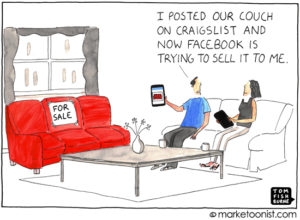It’s a random Tuesday and you are scrolling through your Facebook feed just browsing through friend’s pictures, posts, and status updates and then all of a sudden, those black suede shoes you were looking at the day before, pop up. Wait a minute, what the heck? I know we’ve all experienced this, right? This is not something new to any social media user out there, it’s been happening for a while now. These ads are populated as a result of ‘cookies’ and although users are skeptical about the way Facebook taps into targeting ads, they’re analytics and data about users are the driving force behind these ads.
But we haven’t seen the end of this method. Cue Augmented reality and smart glasses. We know these have been in the works as well but the new craze geared towards marketing is something to take a closer look at. According to a recent Forbes article by Joe Surprenant (2018), these will allow for further marketing strategies. The ability to increase brand awareness by tapping into the consumer’s point of view and instantly generate information about the product (Suprenant, 2018). Aside from this feature tracking a consumer during point of decision will be key, the ability to see the individual reaching for a particular brand of product can allow for brands and competitors to instantly influence the consumers during their buying decisions (Suprenant, 2018).
Considering the use of cookies and analytics that are already tapping into our buying behavior, are we doomed as consumers as technology progresses? Do you want to constantly be reminded of what you searched for, thought about, or passed by?
References
Scheiber, N. (2017, September 28). Facebook’s Ad-Targeting Problem, Captured in a Literal Shade of Gray. Retrieved from https://www.nytimes.com/2017/09/28/technology/facebook-ads.html
Surprenant, J. (2018, February 06). The Future of Marketing Will Be Heads-Up and Hands-Free. Retrieved from https://www.forbes.com/sites/forbesbusinessdevelopmentcouncil/2018/02/06/the-future-of-marketing-will-be-heads-up-and-hands-free/#c956d70501e3


6 Responses to How far is too far?